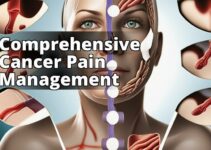I've researched and compiled the most effective pharmacotherapy strategies for cancer pain relief. From opioid analgesics to nonsteroidal anti-inflammatory drugs, this article covers a range of medications that can provide much-needed relief for cancer patients. Whether it's adjuvant medications, corticosteroids, or NMDA receptor antagonists, this comprehensive guide aims to help healthcare professionals and patients make informed decisions about pain management.
Key Takeaways
- Opioid analgesics are commonly prescribed for severe cancer pain relief, but the risk of opioid overdose should be carefully balanced.
- Educating patients and families about the signs of opioid overdose is crucial, and providing naloxone kits for emergency use is recommended.
- Nonsteroidal anti-inflammatory drugs (NSAIDs) can be considered as an alternative option for managing cancer pain, but the potential gastrointestinal and cardiovascular risks should be evaluated.
- Adjuvant medications such as antidepressants, anticonvulsants, corticosteroids, and NMDA receptor antagonists can be effective in controlling neuropathic pain associated with cancer. Exploring alternative therapies and combination therapy strategies is important.
Opioid Analgesics
I prescribe opioid analgesics to alleviate severe cancer pain in my patients. It's crucial to balance the relief they provide with the potential risks, such as opioid overdose. To address this, I educate patients and their families about the signs of overdose and provide naloxone kits for emergency use. Monitoring for signs of opioid addiction is also essential. I work closely with addiction treatment specialists to ensure comprehensive care for patients who may be at risk. While the priority is effectively managing pain, preventing opioid misuse and addiction is a critical part of the treatment plan. By staying vigilant and proactive in addressing these concerns, I strive to provide the best possible care for my patients while minimizing the risks associated with opioid analgesics.
Nonsteroidal Anti-Inflammatory Drugs (NSAIDs)
Nonsteroidal anti-inflammatory drugs (NSAIDs) offer an alternative option for managing cancer pain, complementing the use of opioid analgesics in my treatment approach. However, it's crucial to consider the potential gastrointestinal risks associated with NSAID use in cancer patients. NSAIDs can lead to ulcers, bleeding, and perforation in the stomach and intestines, particularly in individuals with a history of gastrointestinal issues or those taking blood-thinning medications. Additionally, the cardiovascular effects of NSAIDs must be carefully evaluated when used in cancer pain management. These drugs can increase the risk of heart attack and stroke, which is especially pertinent for patients with pre-existing cardiovascular conditions. Despite their effectiveness in alleviating pain, the potential gastrointestinal and cardiovascular complications associated with NSAIDs necessitate a thorough risk-benefit assessment when incorporating them into cancer pain treatment regimens.
Adjuvant Medications
Frequently, adjuvant medications play a crucial role in enhancing the effectiveness of cancer pain management alongside conventional analgesics. When considering adjuvant medications for cancer pain relief, it's essential to explore various alternative therapies and combination therapy strategies. Here are some key points to consider:
- Antidepressants: Medications such as tricyclic antidepressants and serotonin-norepinephrine reuptake inhibitors can help manage neuropathic pain commonly associated with cancer.
- Anticonvulsants: Drugs like gabapentin and pregabalin have shown efficacy in controlling neuropathic pain and are often used as adjuvants in cancer pain management.
- Corticosteroids: These can be beneficial in reducing inflammation and relieving pain, especially in cases of bone metastases and nerve compression.
- NMDA receptor antagonists: Substances like ketamine may be considered in refractory cases to manage severe cancer pain by modulating central sensitization.
Corticosteroids
Corticosteroids play a crucial role in reducing inflammation and alleviating pain, particularly in cases of bone metastases and nerve compression. When used in cancer pain management, corticosteroids can effectively reduce tumor-induced edema and inflammation, leading to a significant decrease in pain levels. However, it's important to be aware of potential side effects associated with corticosteroid use, such as increased blood sugar levels, weight gain, and mood changes. These side effects should be carefully monitored and managed to ensure the patient's overall well-being. Additionally, dosage recommendations for corticosteroids in cancer pain relief should be tailored to each patient based on their specific condition, overall health, and individual response to the medication. Working closely with healthcare providers to monitor and adjust corticosteroid dosages can help optimize pain relief while minimizing potential side effects.
Antidepressants
I'll discuss the use of antidepressants in managing cancer pain, their role in addressing depression, and potential interactions with other medications.
Antidepressants for Neuropathic Pain
The use of antidepressants has been shown to be effective in managing neuropathic pain associated with cancer. Antidepressants can alleviate neuropathic pain through several mechanisms, including the modulation of neurotransmitters involved in pain signaling. Here are four key points to consider regarding the use of antidepressants for neuropathic pain in cancer patients:
- Efficacy of Antidepressants: Studies have demonstrated the efficacy of certain antidepressants, such as tricyclic antidepressants (TCAs) and serotonin-norepinephrine reuptake inhibitors (SNRIs), in providing relief from neuropathic pain in cancer patients.
- Mechanism of Action: Antidepressants act on the central nervous system to modulate the transmission of pain signals, particularly those associated with neuropathic pain, by influencing the levels of neurotransmitters such as serotonin and norepinephrine.
- Side Effects: While generally well-tolerated, antidepressants may cause side effects such as drowsiness, dizziness, dry mouth, and constipation, which should be carefully monitored in cancer patients.
- Individual Response: The response to antidepressant therapy can vary among patients, and careful titration of doses may be necessary to achieve optimal pain relief while minimizing side effects.
Role in Managing Depression
I find antidepressants to be valuable in managing depression in cancer patients. Depression is a common comorbidity in cancer patients, and it can significantly impact their quality of life and pain management. Antidepressants not only help alleviate depressive symptoms but also have a role in modulating pain perception. Additionally, they can enhance the effectiveness of other pain management interventions. Here's a table that summarizes the role of antidepressants in managing depression in cancer patients:
| Benefits of Antidepressants in Cancer Patients | Examples |
|---|---|
| Alleviating depressive symptoms | SSRIs (e.g., sertraline, fluoxetine) |
| Modulating pain perception | SNRIs (e.g., duloxetine, venlafaxine) |
| Enhancing the effectiveness of pain management interventions | TCAs (e.g., amitriptyline, nortriptyline) |
| Supporting psychotherapy for cancer patients | MAOIs (e.g., phenelzine, tranylcypromine) |
In addition to pharmacotherapy, integrating psychotherapy for cancer patients can further contribute to holistic pain management and improved overall well-being.
Potential Drug Interactions
I've identified three significant potential drug interactions involving antidepressants in cancer pain management. When using antidepressants to manage cancer pain, it's crucial to consider potential drug interactions that may affect drug metabolism and lead to potential side effects. Here are the key interactions to be mindful of:
- Serotonin Syndrome Risk: Combining certain antidepressants with other medications, such as tramadol or triptans, can increase the risk of serotonin syndrome, leading to potentially life-threatening symptoms.
- Cytochrome P450 Interactions: Antidepressants like fluoxetine and paroxetine can inhibit cytochrome P450 enzymes, affecting the metabolism of various opioids and chemotherapy drugs.
- QT Prolongation: Some antidepressants, particularly tricyclic antidepressants, can prolong the QT interval, increasing the risk of severe arrhythmias when combined with certain cancer medications.
Understanding these potential interactions is essential for ensuring safe and effective pain management in cancer patients.
Anticonvulsants
I'll start by discussing the use of anticonvulsants for cancer-related neuropathic pain. Additionally, I'll explore the role of anticonvulsants as adjuvants in cancer pain management. These points will provide valuable insights into the effectiveness of anticonvulsants in alleviating cancer-related pain.
Anticonvulsants for Neuropathic Pain
Frequently, anticonvulsants are used to manage neuropathic pain in cancer patients.
- Gabapentin (Neurontin): Often prescribed due to its efficacy in reducing nerve pain.
- Pregabalin (Lyrica): Shown to be effective in managing neuropathic pain associated with cancer.
- Carbamazepine (Tegretol): Useful in treating shooting or lancinating pain in cancer patients.
- Phenytoin (Dilantin): Sometimes utilized to manage neuropathic pain in cancer patients who have not responded to other anticonvulsants.
Anticonvulsants play a vital role in managing neuropathic pain in cancer patients. They work by stabilizing abnormal electrical activity in the nervous system, thereby reducing pain signals. These medications can significantly improve the quality of life for individuals suffering from cancer-related neuropathic pain.
Anticonvulsants as Adjuvants
Anticonvulsants serve as valuable adjuvants in managing cancer pain, complementing primary analgesic treatments to improve overall pain relief. When incorporating anticonvulsants into a cancer pain management plan, dosing considerations are crucial. It's essential to start with a low dose and gradually titrate upwards to achieve optimal pain control while minimizing side effects. Efficacy comparisons between different anticonvulsants can guide the selection process, considering factors such as the patient's specific pain characteristics and comorbidities. While some anticonvulsants may exhibit better efficacy in certain types of cancer pain, individual patient response can vary. Therefore, close monitoring and a personalized approach are essential to ensure the best possible outcomes. By integrating anticonvulsants as adjuvants in cancer pain management, healthcare providers can enhance the overall effectiveness of pain relief strategies.
NMDA Receptor Antagonists
When treating cancer pain, I have found that NMDA receptor antagonists are often effective in managing severe pain that is not well controlled with other medications. These antagonists work by blocking the N-methyl-D-aspartate (NMDA) receptor, which plays a crucial role in the transmission and perception of pain. In my clinical experience, I have observed the clinical efficacy of NMDA receptor antagonists in providing relief for patients experiencing neuropathic pain, opioid-resistant pain, and breakthrough pain. Additionally, these medications have shown promise in reducing opioid tolerance and dependence, making them valuable in comprehensive pain management strategies. The use of NMDA receptor antagonists has also been associated with a lower incidence of adverse effects compared to traditional opioid-based therapies, further highlighting their potential in cancer pain relief.
Topical Analgesics
I have found topical analgesics to be a valuable addition to my cancer pain management toolkit. Their efficacy in providing localized pain relief has been impressive. When using topical analgesics, proper application techniques are crucial for optimal results. I've observed that massaging the topical agent into the affected area can enhance its absorption and effectiveness. Additionally, the safety profile of topical analgesics is favorable compared to systemic medications, as they are associated with minimal systemic side effects. Common side effects, such as mild skin irritation, are usually local and transient. This makes them a suitable option, especially for patients with specific comorbidities or those already taking multiple systemic medications. Considering their efficacy, favorable safety profile, and minimal side effects, topical analgesics have become an integral part of my approach to cancer pain management.




